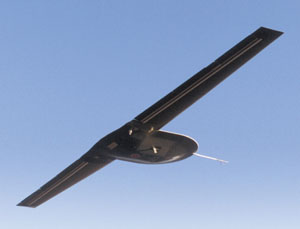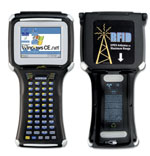Security Initiatives Drive Technology Development
 |
| Unmanned aerial vehicles are used extensively in current operations and to some degree to patrol borders; however, size and power requirements may limit extensive use in homeland security efforts. |
Biometric scanners, gamma ray detectors and unmanned underwater vehicles seem like topics reserved for futuristic action-adventure movies. However, these technologies are being embraced by agencies under the U.S. Department of Homeland Security’s umbrella. Technologies that serve to track, trace and contain or detain potentially harmful materials and individuals are being studied, tested and integrated into many homeland security activities.
The department’s focus, borne out of security initiatives stemming from the September 11, 2001, terrorist attacks, continues to evolve as new perceived threats to the
Several notable technologies were cultivated through DHS initiatives and grants in 2005. For example, although unmanned aerial vehicles (UAVs) have existed in various forms since the 1950s, the aircraft were applied widely in the
The military will make UAVs an integral part of soldiers’ resources in the future. In October 2005, the Army’s first demonstration of the Future Combat Systems included a public demonstration of the unmanned RQ-8 Fire Scout UAV.
Domestically, UAVs began monitoring the country’s borders in 2004. Similar to their use in the Iraq and Afghanistan theaters of operation, these UAV missions allow the U.S. Border Patrol a better surveillance position to track and observe—from far distances—vehicles and individuals entering the country.
But, as Kirk Evans, director, mission support office, HSARPA, pointed out in the opening statement of his Senate testimony in April 2005, UAVs have limitations in this type of mission. Although the surveillance equipment is effective, the size and power requirements of UAVs create obstacles. In addition, the aircraft’s progress is hindered by the Federal Aviation Administration’s flight restrictions. On March 25, 2005, U.S. Customs and Border Protection (CBP) deployed airplanes to fill in the gaps of UAVs. Although they provide an effective short-range monitoring tool, it is unclear whether they will become the crucial element in the border patrol’s strategy or simply another tool integrated into the agency’s overall surveillance methods.
Biometrics is another area of interest for the DHS. Public and private officials highly touted biometric security in 2005 as a key method for protecting the nation’s borders, commerce and citizens’ identities. Biometrics software and hardware sensors measure unique biological characteristics that can be stored electronically, including fingerprints and iris scans as well as voice and facial recognition.
As part of DHS’ United States Visitor and Immigrant Status Indicator Technology (US VISIT) program, the department installed biometric entry procedures in 50 land border ports, 115 airports and 15 seaports in 2004. CBP officers collect digital, inkless finger scans and take a digital photo of a visitor who applies for entry with a nonimmigrant visa.
In October 2005, the DHS announced a significant expansion of the US VISIT biometric security process to other land port entries. The department also is exploring methods of integrating radio frequency identification technology into the visitor-tracking process by embedding chips into travel documents. Antennas installed at entry and exit points will read the information stored in the chips. Biometrics usage also increased at the local and state law enforcement agency levels as more contracts were signed with different biometric vendors in 2005.
As with any emerging technology, operational standards and integration are the keys for success and universal implementation. Numerous companies have developed different biometrics sensors specialized to both the government and private sectors. However, potential clients are apprehensive about spending time and capital on a biometric system that could become obsolete by rapid technological change or industry standards. Some question the reliability of the technology, suggesting that external variables may affect future recognition. For example, if during the photography session a subject’s face is lit from one side, the sensors may not be able to read that image accurately. Finally, third-party system integrators may play an integral role in the development of the technology because a cost-effective strategy could be to link legacy systems instead of replacing early investments.
Yet another focus for the DHS is underwater threats. Before September 11, it was hard to imagine a swimmer carrying explosives into a harbor and turning ships into missiles. Now, the department is exploring all nightmarish scenarios that could happen at
Two technologies for detecting submerged threats are sonar and unmanned underwater vehicles (UUVs). Sonar systems present a superior alternative to optical surveillance systems and provide clarity in a dark, murky environment. In 2005, HSARPA issued grants to several companies to study the feasibility of various sonar detection methods, such as systems that provide a hailing option that can temporarily incapacitate potential intruders.
Underwater surveillance monitors can be placed in a fixed position or on board a UUV that can travel within the port boundaries. UUVs also have applications other than port security, including mine detection, fixed-water security and maintenance near dams and in sewer systems, assistance in search and rescue in lakes and oceans, and telecommunications cable inspection.
The success of these surveillance technologies depends on the ability to survey all activities underwater with accuracy and greater range, allowing port authorities to make more informed decisions and to prepare possible countermeasures without generating a high frequency of false alarms. Moreover, many 2005 HSARPA grant proposals suggest that cost efficiency of the surveillance technology is equally important as detection accuracy.
Additional port security technologies include the detection of nuclear materials in cargo entering ports. Radioactive isotopes and the potassium-40 found in bananas can create similar readings when detected by current radiation portal monitors installed in
 |
| Using radio frequency identification, or RFID, technology, data chips can be embedded in travel documents and scanned at border entry and exit points to track visitors to the United States. |
In addition to protecting
The DHS and the military have several initiatives dedicated to the development of this technology. The U.S. Air Force’s Directed Energy Directorate announced in 2005 the development of a laser system that temporarily weakens people by shining a high frequency light directly in their eyes.
Other technologies under development involve super-bright light emitting diodes that attempt to produce the same nonlethal force as the laser system. Many police forces around the country employ devices that shoot electric stun projectiles and temporarily debilitate muscles.
Additional nonlethal methods to incapacitate an aggressor momentarily include shooting active liquids through high-pressure nozzles. The limitations to these technologies are adverse body reactions, such as the possibility of inducing a heart attack, as well as precision and scale of the force; however, longer range electric projectiles are being developed. As these technologies are developed and used on the battlefield and in national security solutions, it is foreseeable that the technology will continue to be integrated into local police forces.
With the appearance of new external security and political drivers, focus on specific technologies may take different directions. One example of a new external driver may be massive outbreaks of contagious diseases, such as the bird flu, which could create more attention on biodefense resources.
Furthermore, as government and early-adopters are taking the lead in testing and using this technology, it also is probable that some of this technology will cross over to many other industries. For example, because protection of corporate and client information remains a constant challenge for chief information officers and chief technology officers, it is conceivable that biometrics will become a bigger part of the commercial workplace. Health care, financial and video game companies have announced recently that they have signed contracts with certain biometric vendors to manage part of their internal security procedures.
Massive nondiscretionary outlays and continued budget deficits are placing pressure on government spending including national defense. But the transformation in focus from traditional warfare to homeland security and anti-terrorism should protect the DHS from future spending cuts. With a DHS budget projected to remain at current levels, the government-led initiatives to push innovation and to reduce intrinsic technology limitations will continue driving this technological revolution. Although all of these technologies existed before the creation of the DHS, the agency has created a greater incentive for academia and the private sector to deliver new solutions for current security dilemmas.
Web Resources
Homeland Security Advanced Research Projects Agency: www.dhs.gov/dhspublic/interapp/editorial/editorial_0344.xml
The Biometric Consortium: www.biometrics.org
U.S. Marine Corps Joint Non-Lethal Weapons Program: https://www.jnlwp.com/mission.asp
The McLean Group: www.mcleanllc.com/main.html
Braun Jones is the president and Nick Bundy is a senior analyst with The McLean Group, an investment bank located in McLean, Virginia, that provides merger and acquisition advisory services to middle-market businesses.




Comments